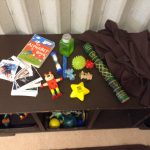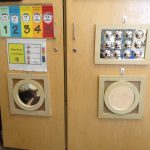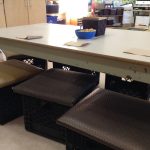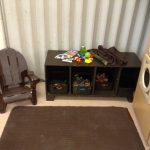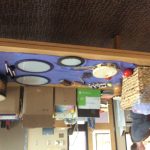As a kindergarten team, we explored how to implement self-regulation strategies to assist individuals who are struggling with behaviours as well as provide strategies for the entire class. We seem to be facing an epidemic of children and adults/parents who are overwhelmed by these behaviours resulting in a stress cycle. Self-regulation is about understanding the behaviour, why it is happening and why at this time is it happening (what is the cause of the behaviour). Student well-being and self-regulation have become a major focus in the kindergarten program, thus resulting in our reflection concerning the needs of our students and how we approach self-regulation. By doing this we are not only creating a calmer more peaceful classroom for our students but also for us, the adults within the room. Stuart Shanker explains that “we experience limbic resonance, an adult’s response to the stress that children bring into classroom, the children’s stress transfers to those around them.”
Team Members
Susan Baldassi
Thunder Bay Catholic District School Board
Anna Tocheri
Thunder Bay Catholic District School Board
Donna Paxton
Thunder Bay Catholic District School Board
Professional Learning Goals
The professional learning goals we achieved were to build inclusive and engaging environments in our classrooms. We wanted all students to have the opportunity to learn in a safe, welcoming and healthy environment where they experience respect, caring, stewardship and multiple opportunities for student voice allowing them to feel connected, valued and empowered. We gave them the tools to assume ownership for their learning, demonstrate resilience and perseverance and develop self-belief, self-advocacy and self-regulation.
Activities and Resources
- We attended at a two-day conference in Ottawa on self-regulation with Dr. Stuart Shanker
- We participated in a “30-Day Self-Regulation Challenge” through the MEHRIT Centre focusing on and exploring stressors across all five domains (biological, emotional, cognitive, social and prosocial) as well as the “5 Steps of Self-Reg” to deal with stressors
- Daily Self-Reg videos with Dr. Stuart Shanker as well as choices of learning options for exploring our personal Self-Reg and actions for putting what we learned into practice
- Sensory tools – sensory sock and a variety of fidget toys (squishy balls, small finger puppets, sand timers, figurines)
- Calming area
- Self-regulation choice cards
- Mirrors (for students to “see” emotion)
- The five-point scale (to identify how they are feeling and how they want to feel)
- Different types of seating – low kneeling table, a lower table with milk crates and cushioned tops as seats, regular chairs and standing tables
- Dr. Stuart Shanker Resources – www.self-reg.ca
- Guided Visualization – www.innerhealthstudio.com
- Yoga and Mindfulness Videos – http://www.cosmickids.com
- Me Moves – www.thinkingmoves.co
- Dance in French – www.jedessine.com
- Go Noodle – https://www.gonoodle.com
Unexpected Challenges
Our local elementary teacher federation, of which we are part of, had ongoing work sanctions that started in June 2016 and were ongoing until mid-February 2017. This made sharing with our professional colleagues difficult.
Many of the changes we implemented in our classrooms took time and energy and there was also a cost factor. Although we appreciated the support of OTF and the school, it was challenging to prioritize the resources necessary to fully implement self-regulation strategies like micro environments, flexible seating, restorative, and sensory tools and supports.
Enhancing Student Learning and Development
Resources and strategies were developed to assist and help not only individual students with concerns, but the entire class. We used some existing resources and created our own resources to focus on the specific needs in our classrooms.
The activities we conducted to meet our goals were:
- Conferring with individual students and parents to determine which of the five domains may need to be addressed to assist in self-regulation strategies
- Creating goals with children to use self-regulation strategies and helping students to identify and name their feelings
- Developing self-regulation strategies that are effective for children to help promote their well-being
- Engaging in inquiry investigation on effective strategies/tools/techniques
- Analyzing the documentation with colleagues
- Using iPads and technology (Me Moves, Go Noodle, Cosmic Kids Yoga) as tools to assist in self-regulation strategies
- Experience with five element movement mediation sessions which promote self-regulation through movement and music
Sharing
We have developed lists of resources and materials that have been beneficial during our learning. This toolkit will be shared with other kindergarten teachers within our school and hopefully within our board.
Project Evaluation
We worked collaboratively to create strategies on how to teach self-regulation skills and concepts, reviewed personal and student growth together, and planned next steps for learning and teaching. The professional learning goals that we had hoped to achieve were to build inclusive and engaging environments in which all students have the opportunity to learn in a safe, welcoming and healthy environment. They experienced respect, caring, stewardship and multiple opportunities for student voice allowing them to feel connected, valued and empowered and assume ownership for their learning. We feel that we achieved the above professional learning goals as well as providing effective and useful strategies not only for those individual students with behaviour concerns, but also all those who were in the classrooms gained valuable strategies and benefited from our learning. Our classrooms were calmer, thus helping both students and educators to have better days.
Resources Created
These resources will open in your browser in a new tab, or be downloaded to your computer.


